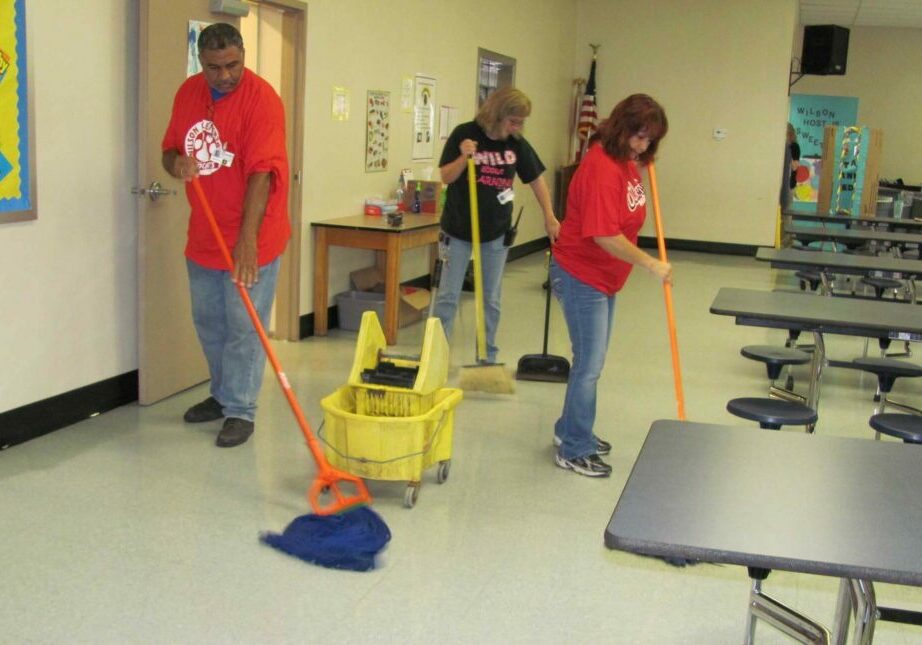Local association teamwork saves the day
At Cherry Hill High School East, a water leak left unattended for the summer caused extensive mold growth in dozens of classrooms. In late July, the administration ordered custodians to remediate it, and threatened their jobs if they did not, even though they lacked training and protective equipment.
The workers contacted Cherry Hill Education Association President Martin Sharofsky, who told them not to do it, and asked NJEA UniServ field representative Nancy Holmes come to the site. Holmes arrived immediately, took photos, and phoned NJEA health and safety staff contact Thomas Hardy and an industrial hygienist from the New Jersey Work Environment Council (WEC). They confirmed that the custodians should not do the work.
Holmes also contacted an NJEA lawyer, who called New Jersey Public Employees Occupational Safety and Health (PEOSH), which told the administration they had to hire a contractor. As a result, the work was done properly and no one’s job was lost.
The custodians, who only recently had joined the same bargaining unit as the teachers, saw the power and importance of association protection, and the value of teaming up with NJEA partners. In addition, the success energized a nascent health and safety committee.
Many hazards
Because custodians are asked to clean just about everything in and around schools, they face a wide array of health and safety issues. These include lifting, heat and cold stress, psychological stress—especially with overwork and threat of layoffs—and many chemical and biological hazards. Some important chemical and biological hazards are discussed below.
Mold and floods
Mold is an ongoing school problem, associated with water intrusion. Mold may have been the main hazard after Superstorm Sandy, but not the only one. Flood waters may contain toxic chemicals from nearby industry or underground waste sites. There may also be microorganisms, especially if area sewage treatment plants overflowed.
Personal protective equipment (PPE) for mold should include a respirator, safety glasses or goggles, full body protective clothing, long gloves, and safety shoes. For flood waters, high boots are required. The respirator must be provided in compliance with the PEOSH Respiratory Protection Standard described below. For more than 10 square feet of mold-damaged material, workers should be provided training in safe removal practices and environmental protections, such as enclosure and exhaust ventilation.
Other chemicals
Custodians may encounter solvents, pesticides, concentrated cleaning solutions, lead, and other chemicals. The first and best way to minimize exposures to cleaning products is for the school or district to adopt a green-cleaning chemicals program, including use of certified least-toxic products, clear written protocols for their use, and training. For pest control, New Jersey law requires that toxic chemicals be used only as a last resort.
Whatever chemicals are used, the PEOSH Hazard Communication Standard requires that workers be trained in product hazards, proper handling, measuring, mixing, and storing of chemicals, and protective equipment needed. In addition they must have access to a list of hazardous chemicals in the school, and material safety data sheets (MSDSs), which are information sheets developed by manufacturers about a particular chemical product.
The PEOSH Respiratory Protection Standard requires:
- Selection of the appropriate respirator.
- Medical clearance to use one.
- Fit testing.
- Proper cleaning and storage.
- Training in all of the above as well as donning and doffing the respirator and daily fit checks.
The PEOSH PPE standards cover protection of head, eyes, hands, feet, and body. The standards require the district to:
- Provide PPE appropriate to hazards.
- Ensure PPE comfort and fit.
- Inspect, clean, and maintain PPE and dispose of contaminated PPE.
- Train staff in PPE use.
Asbestos
The federal AHERA (Asbestos Hazard Emergency Response Act) requires the district to inspect the school every three years and remove any damaged asbestos. But only certified employees of asbestos contractors licensed by the New Jersey Department of Labor can do asbestos abatement. It is illegal for custodians to do it.
Bloodborne pathogens
Bacteria, viruses, and other pathogens (disease-causing organisms) are found in human bodily fluids. The PEOSH Bloodborne Pathogens Standard requires coverage of anyone whose job duties include potential exposure to blood or other bodily fluids, such as saliva, vomit, sweat, tears, urine, and feces.
Covered employees must be trained in the requirements of the standard, be offered Hepatitis B vaccinations, and receive a health evaluation within hours of actual blood exposure.
Pathogens covered by the standard include, but are not limited to, hepatitis B virus; hepatitis C virus; and human immunodeficiency virus (HIV), the virus that causes AIDS. Hepatitis B is of the greatest concern because it is 50 to 100 times more infectious than HIV/AIDS. Hepatitis B virus can survive on surfaces for a week or more.
A key question for local associations is, “Who is covered?” It is up to the district to decide, and many districts do not cover custodians. Local associations should work with the UniServ field representative to negotiate contract language that ensures that custodians are covered under the PEOSH Bloodborne Pathogens Standard.
Administrators and the local board of education should not direct employees to engage in activities that are a violation of the contract, district policy, or statute. Nonetheless, under normal circumstances, members are advised to follow administrators’ directives, but immediately call the local association leadership so that appropriate action can be taken. To ignore the directive would risk a charge of insubordination.
However, if employees are directed by an administrator or board member to do something that is criminal or that endangers their life, health or safety, they should refuse to carry out the directive and immediately call their association representative, local president, or UniServ rep.
